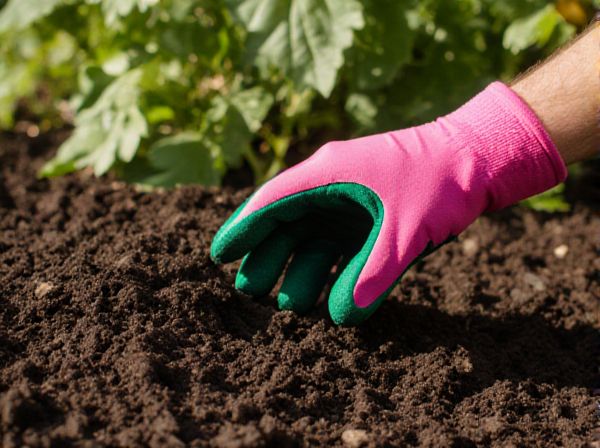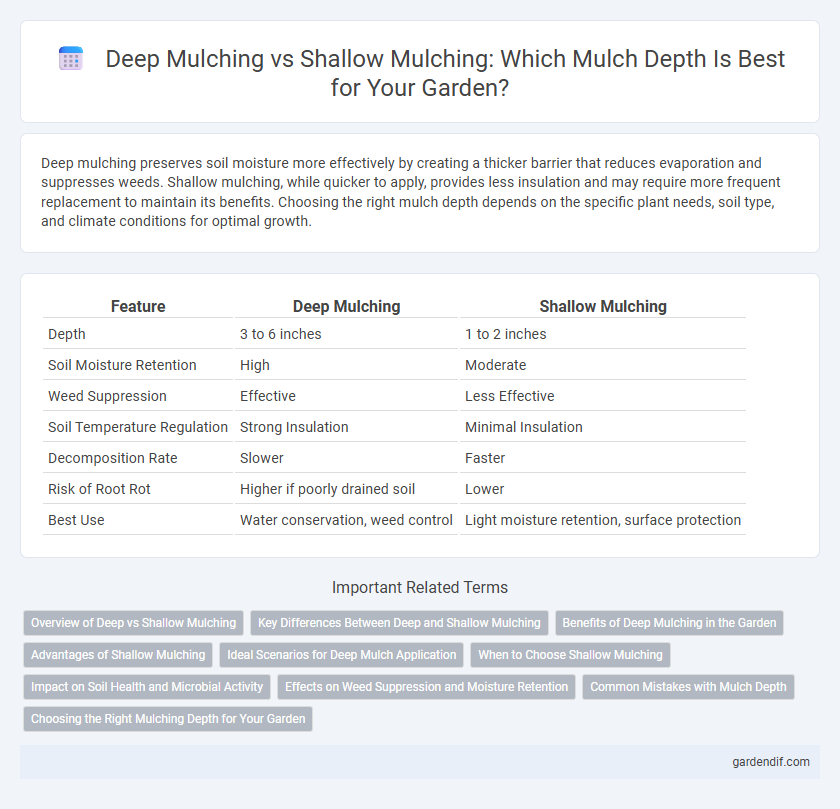
Deep Mulching vs Shallow Mulching Illustration
Deep mulching preserves soil moisture more effectively by creating a thicker barrier that reduces evaporation and suppresses weeds. Shallow mulching, while quicker to apply, provides less insulation and may require more frequent replacement to maintain its benefits. Choosing the right mulch depth depends on the specific plant needs, soil type, and climate conditions for optimal growth.
Table of Comparison
| Feature | Deep Mulching | Shallow Mulching |
|---|---|---|
| Depth | 3 to 6 inches | 1 to 2 inches |
| Soil Moisture Retention | High | Moderate |
| Weed Suppression | Effective | Less Effective |
| Soil Temperature Regulation | Strong Insulation | Minimal Insulation |
| Decomposition Rate | Slower | Faster |
| Risk of Root Rot | Higher if poorly drained soil | Lower |
| Best Use | Water conservation, weed control | Light moisture retention, surface protection |
Overview of Deep vs Shallow Mulching
Deep mulching involves applying a thick layer of organic materials, typically 3 to 6 inches, which improves soil moisture retention, suppresses weeds, and enriches soil nutrients through gradual decomposition. Shallow mulching, with a thinner layer around 1 to 2 inches, offers moderate weed control and moisture conservation but requires more frequent reapplication due to faster breakdown. Selecting between deep and shallow mulching depends on soil type, plant needs, and maintenance capacity, with deep mulching favored for long-term soil health and shallow mulching suited for short-term or sensitive root environments.
Key Differences Between Deep and Shallow Mulching
Deep mulching involves applying a thick layer of organic material, typically 3 to 6 inches, which enhances moisture retention, suppresses weeds more effectively, and improves soil structure over time. Shallow mulching uses a thinner layer, usually 1 to 2 inches, providing moderate weed control and moisture conservation but requiring more frequent replenishment. The key differences lie in their impact on soil health, weed suppression efficacy, and maintenance frequency, with deep mulching promoting longer-term soil benefits and less upkeep.
Benefits of Deep Mulching in the Garden
Deep mulching enhances soil moisture retention by creating a thick barrier that reduces evaporation and promotes consistent hydration for plant roots. It improves soil structure and fertility by encouraging beneficial microbial activity and organic matter decomposition at a deeper level. This method also suppresses weed growth more effectively, reducing competition for nutrients and supporting healthy, vigorous plants in the garden.
Advantages of Shallow Mulching
Shallow mulching preserves soil structure and promotes better aeration, enhancing root respiration and microbial activity. It reduces the risk of moisture retention issues such as root rot by allowing excess water to evaporate more efficiently. This method requires less organic material, making it a cost-effective choice for gardeners seeking moderate weed control and temperature regulation.
Ideal Scenarios for Deep Mulch Application
Deep mulching is ideal for newly planted trees and shrubs as it promotes deep root growth and enhances moisture retention in the soil profile. This technique is particularly effective in arid regions or landscapes with sandy soils that require sustained hydration and insulation against temperature fluctuations. Applying mulch layers of 4 to 6 inches helps suppress weeds and improves soil structure, making deep mulching essential for establishing healthy, resilient plants.
When to Choose Shallow Mulching
Shallow mulching is ideal for young plants and seedlings because it prevents root suffocation and allows for better air and water penetration. This method is also beneficial in areas with clay soil, as it helps improve soil structure without causing excessive moisture retention. Choose shallow mulching to protect shallow-rooted plants while maintaining soil health and preventing fungal growth.
Impact on Soil Health and Microbial Activity
Deep mulching significantly improves soil health by enhancing moisture retention and promoting robust microbial activity through increased organic matter decomposition. Shallow mulching offers moderate benefits, primarily reducing surface evaporation but less effective in fostering deep soil microbial communities. Studies show that deep mulch layers boost nutrient cycling and soil structure, leading to healthier plant roots and greater ecosystem resilience.
Effects on Weed Suppression and Moisture Retention
Deep mulching enhances weed suppression by creating a thicker barrier that blocks sunlight, preventing weed seed germination more effectively than shallow mulching. It also significantly improves moisture retention by reducing evaporation and maintaining consistent soil temperature, promoting healthier plant growth. In contrast, shallow mulching offers limited weed control and moisture conservation, often requiring more frequent replenishment to sustain benefits.
Common Mistakes with Mulch Depth
Excessive mulch depth exceeding 4 inches often leads to oxygen deprivation in soil, causing root rot and poor plant health. Conversely, shallow mulching under 2 inches fails to adequately suppress weeds and retain soil moisture, reducing mulch effectiveness. Proper mulch application balances depth to promote optimal soil aeration, moisture retention, and plant growth.
Choosing the Right Mulching Depth for Your Garden
Selecting the appropriate mulching depth is crucial for garden health, with deep mulching generally ranging from 3 to 6 inches and shallow mulching about 1 to 2 inches. Deep mulching conserves soil moisture, suppresses weeds effectively, and enriches soil organic matter, while shallow mulching is suitable for plants needing more air circulation and less risk of root rot. Evaluating soil type, plant species, and local climate ensures the optimal balance between moisture retention and root aeration, preventing problems like fungal growth or nutrient deficiencies.
Deep Mulching vs Shallow Mulching Infographic

 gardendif.com
gardendif.com